After my thesis defense at the University of Maryland, my mentor and friend E-an Zen asked me if I had ever heard of the Purgatory Conglomerate. I had not. Over the years, E-an has been a great source of new ideas and information to me, and so when he raises a notion, I pay attention.
In my thesis, I had done some strain analysis on volcanic clasts in a meta-ignimbrite that had developed foliation and lineation in Mesozoic shear zone in California’s high Sierra, and that reminded E-an of a rock he had once seen which was screaming for similar treatment: the Purgatory Conglomerate.
On my summer travels this year, I finally had the opportunity to swing through Newport, Rhode Island, and check it out in person. To me as a structural geologist and Zen devotee, this was like nirvana. Check it out:
I was very excited to be there. Here’s me enthusiastically embracing a watermelon-sized clast:
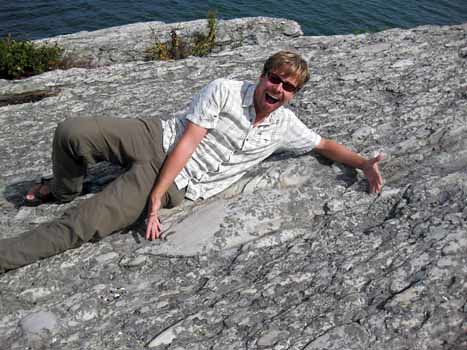
Looking along the trend of the stretching lineation (which is pretty much non-plunging):
Most of the clasts are quartzites of various flavors… Depositionally, it’s a relatively mature conglomerate.
Here’s looking “down the barrel” of the stretched clasts in a big boulder sitting atop the outcrop:
Here’s a really big clast, with local beer cans for scale (not mine, I swear):
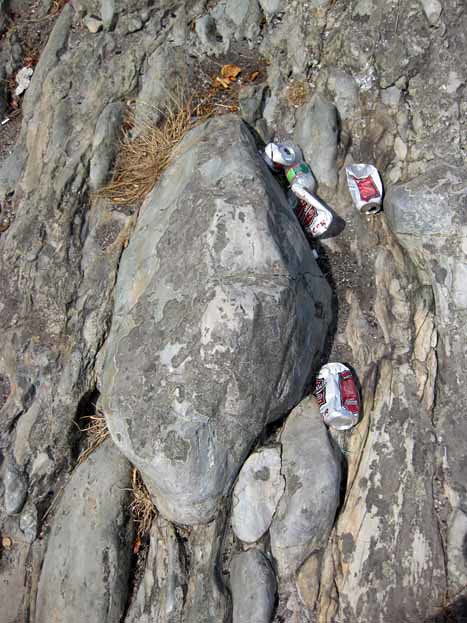
Here’s a really long clast:
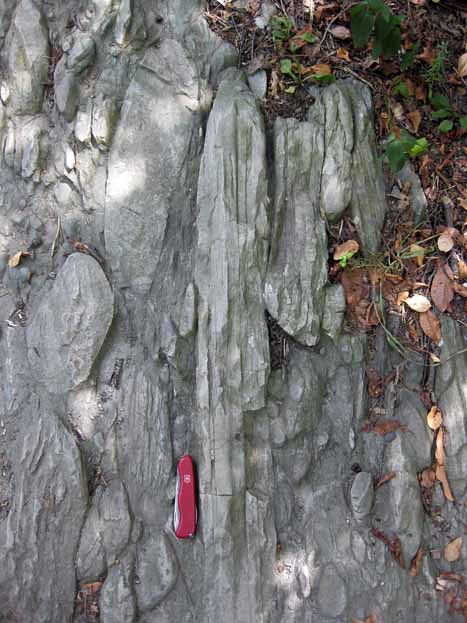
Recall that my Swiss Army knife is 11 cm long, but even without the specific unit, you can see that this clast has an axial ratio (on the plane of the outcrop) of roughly 7:1.
Here’s another long one with an axial ratio of 7:1, with a bonus feature. It displays internal bedding (of the sandstone it was originally derived from):
This is totally awesome. These cobbles, boulders, and pebbles have flowed into elongated shapes! We can use the geometric term “prolate” to describe their cigar-like or hot-dog-like forms.
It’s not all conglomerate there. There are some meta-sandstone bodies too. Here’s an example of sandstone meeting conglomerate:
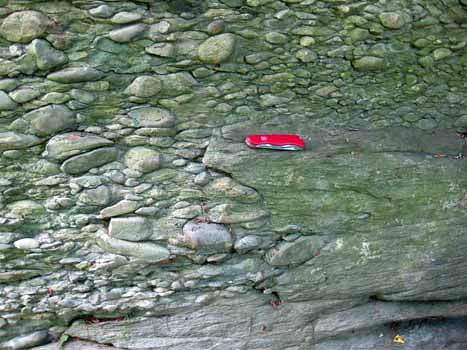
Even cooler: here’s bedding: lenses of conglomerate within sandstone:

Annotated copy of that same photo:
(I once showed you something similar from the Sierra Crest Shear Zone: check photo C of this archived post.)
So how did the Purgatory Conglomerate get so distinctively deformed? Close examination of the rock suggests the main mechanism was pressure solution:
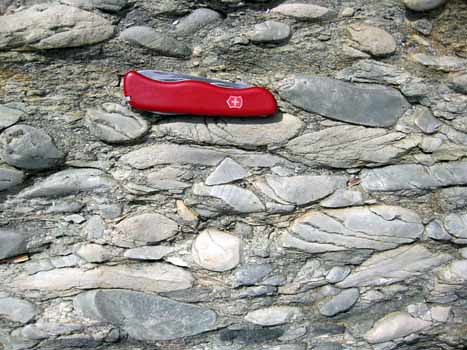 In the photo above, look below the Swiss Army knife for a triangular clast, and trace out its boundaries. You will see that it impinges on the hot-dog-shaped clasts immediately next to it. This triangular grain is encroaching on its neighbors’ territory! Now, one way to interpret this is that the original clasts had shapes which, jigsaw-puzzle-like, were perfectly formed to accommodate their neighbors’ shapes. But that seems rather unlikely, especially when you consider the ten gazillion clasts in this outcrop, all perfectly locked together.
In the photo above, look below the Swiss Army knife for a triangular clast, and trace out its boundaries. You will see that it impinges on the hot-dog-shaped clasts immediately next to it. This triangular grain is encroaching on its neighbors’ territory! Now, one way to interpret this is that the original clasts had shapes which, jigsaw-puzzle-like, were perfectly formed to accommodate their neighbors’ shapes. But that seems rather unlikely, especially when you consider the ten gazillion clasts in this outcrop, all perfectly locked together.
Instead, the idea is that high pressure points (the edge of one round cobble touching an adjacent round cobble, for instance) are sites where certain minerals will go into solution. Quartz is both a common mineral and a mineral which will dissolve under high pressure and re-precipitate under lower pressure. Calcite pulls the same trick — that’s where stylolites come from. [Many nice examples of stylolites and other pressure-solution features here.]
Here’s another nice example showing how the individual clasts lock together with one another, suggesting part of their outer edge has dissolved away:
Here, too. See if you can pick out a few examples of where one clasts impinges on its neighbor. A refresher course may be found here.
Time for a different perspective. Unlike most of the previous pictures, this one is taken looking along the long axis of the clasts.
Zooming in for a closer look at that same photograph, the yellow areas highlight areas where one grain impinges on a neighboring grain:
If there are particularly large clasts, they may shelter smaller neighbors in their “pressure shadow,” immediately adjacent to them. Think of a building collapsing during an earthquake, with a strong central pillar. If you stand next to that pillar, you’re less likely to have the ceiling collapse on your head, since the pillar is protecting you. With that in mind, examine this part of the outcrop:

Since the long axes of the clasts runs left-to-right, that suggests that they were squeezed top-to-bottom. Therefore, the area immediately to the left of the giant clast would be “protected” from the highest pressures by the bulk of its large neighbor. If we zoom in there…
 …we see clasts whose long axes are not aligned with the rest of the outcrop. They are pointed in several other directions, and/or are not as prolate as the rest of the clast population.
…we see clasts whose long axes are not aligned with the rest of the outcrop. They are pointed in several other directions, and/or are not as prolate as the rest of the clast population.
Here’s an annotation of the zoomed-in view, showing the orientation of the long axis of the grains in this outcrop plane:
The implication is that these “protected grains” were less subject to pressure solution than the grains which weren’t lucky enough to have a giant neighbor immediately “next door” (along strike).
In addition, it seems that the strain (deformation/stretching) of the clasts was more severe in some locations, and less severe in other locations. Here, my hands bracket a zone of less deformed (more spheroidal, less prolate) clasts within the overall outcrop of strongly deformed clasts:
The Purgatory Conglomerate is preserved at a spot called Purgatory Chasm. Here’s a shot of the chasm itself, cutting through the conglomerate outcrop down to the Atlantic Ocean. I’d guesstimate that it’s 10 m deep or so:

Here’s the Chasm, further out where the rock is clean of vegetation:
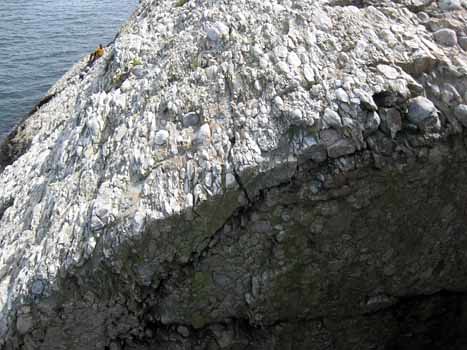
For a nice perspective on the whole area, check out this Quicktime 360° view.
So why is the Chasm there? We may get some insights by taking a look at another feature seen at the outcrop: a joint set which runs ~perpendicular to the long axis of the clasts:

A wider view, showing the same orientation of joints cutting across the conglomerate, ~perpendicular to the stretching lineation. Sunbathers at upper left for scale:

Now let’s go back to the Chasm, and take a look into it. Windsurfing board (washed out in daylight beyond the cleft) for scale: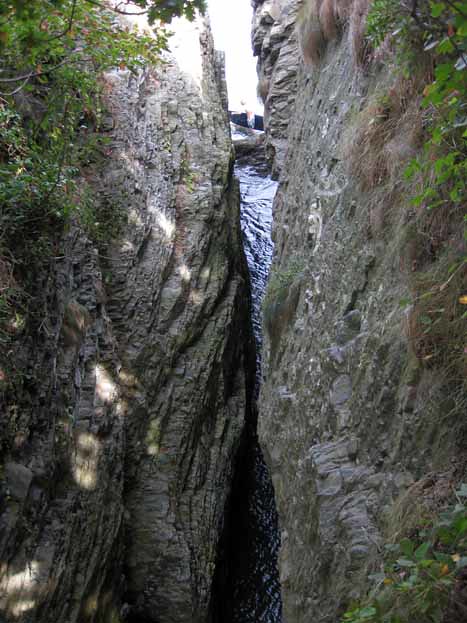
There are a whole lot of joint faces there, all (a) perpendicular to lineation, and (b) parallel to the Chasm. You can see them all as parallel lines to the left of the Chasm. The large concentration of fractures in the area of the Chasm suggests that the Chasm was eroded out along a zone of more pervasively fractured rock. As you stand there and peer in, waves will come in and slosh towards the back end of the Chasm. But why is it so fractured here? I’m not sure.
In other places, you can see fractures that have “healed” into quartz veins: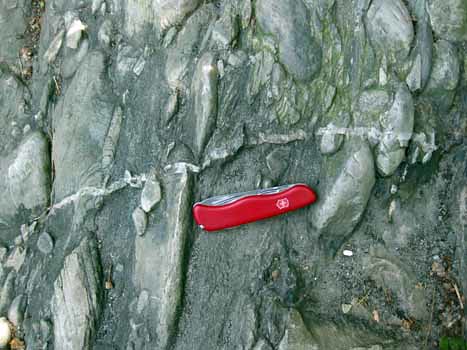
This is where some of that dissolved quartz ends up, sealing shut these cracks. But not all the quartz veins I saw were perpendicular to lineation; there were some that were ~parallel to it, as in this photograph:
As a totally gratuitous bonus, the Purgatory outcrop also features glacial striations. In both of the following two photographs, the striae run from upper right to lower left:
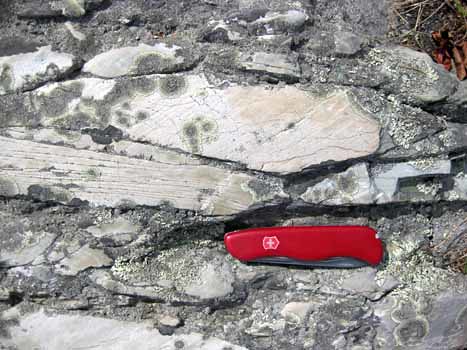
Another spot, showing the same thing:

Annotation showing which lines are bedding traces internal to the quartzite cobbles, and which are glacial striations:
I’ve got a few more photos of my visit to Purgatory in this Flickr photo set.
So: Thanks, E-an, for another great idea! What a cool place; I can’t wait to bring students back here…

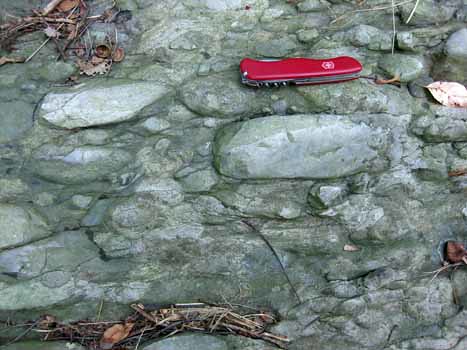

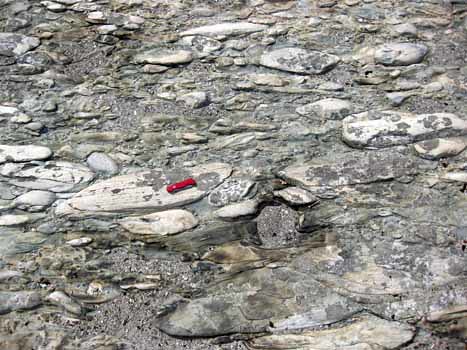
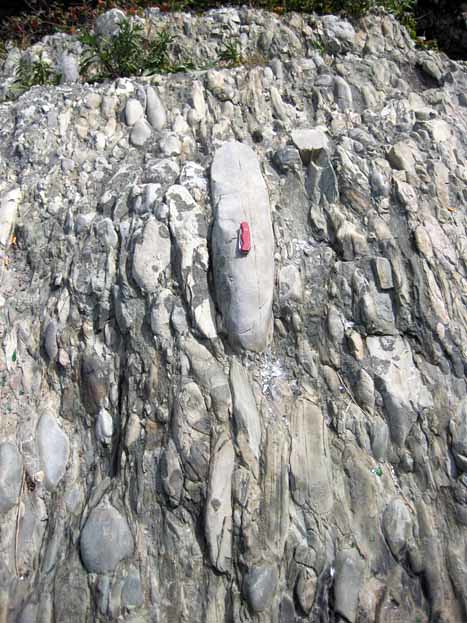
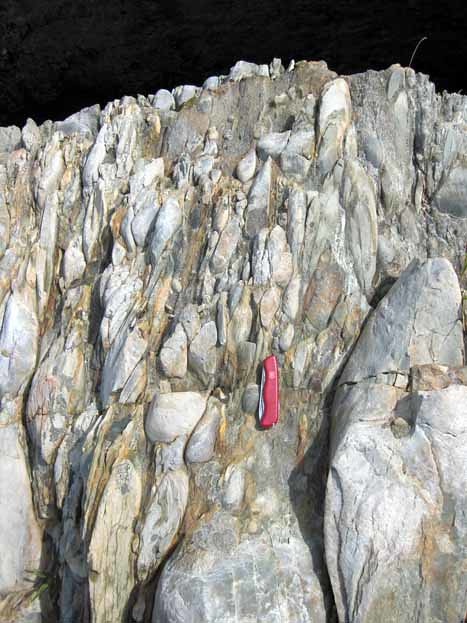

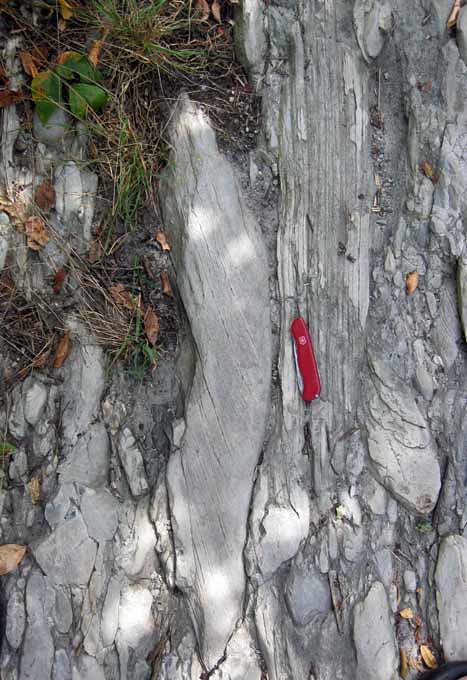
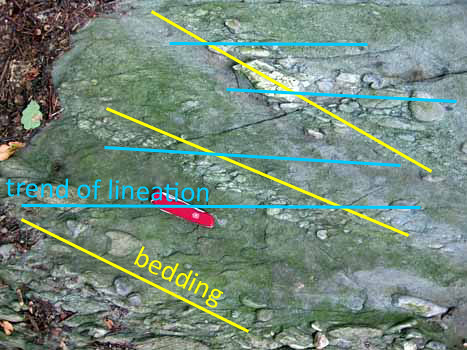
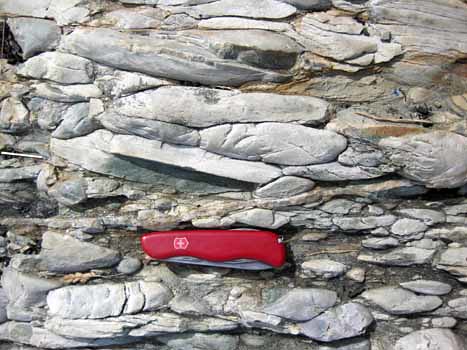

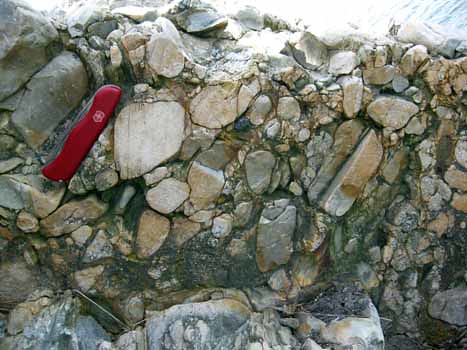
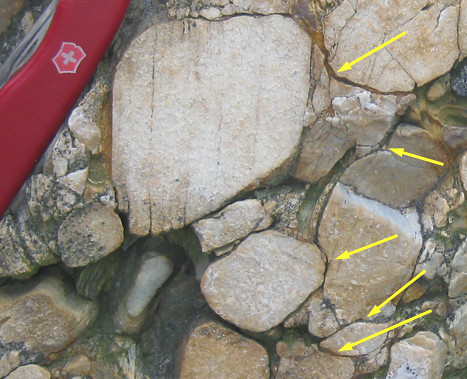
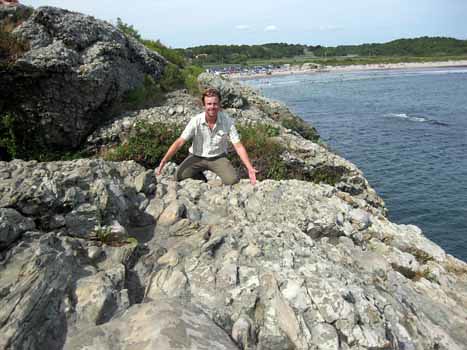
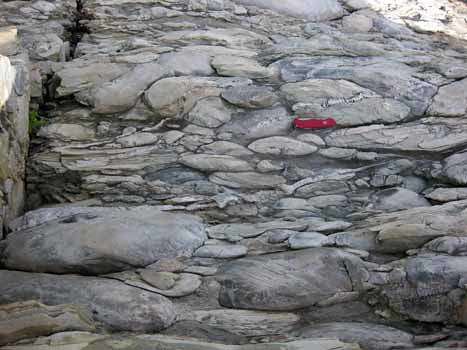
In Montana near Cardwell, on old US 10 is the LaHood formation a precambrian conglomerate that looks very much like this. It is best exposed in the Jefferson River Canyon.
Best to search on LaHood formation for details. Since it is very near the Indiana Univ Field camp a lot of work has been done on it.
Hi Lyle,
I’m familiar with the LaHood Formation. Here’s an earlier post I put up on a chunk of it I collected in Jefferson River Canyon. What a great place, and a great rock, but it isn’t as stretched as the Purgatory Conglomerate, not by a… (wait for it) …long stretch.
Thanks for your comment regardless!
Callan
That is one awesome conglomerate. Thanks for all the photos illustrating the fabric.
Side note because you mentioned your mentor E-an Zen – when I was a grad student at Va Tech, he was visiting the Dept. and was being shown around by Dave Wones the DH. I was really hoping to meet him because I had grown up in Wash. Co. NY and had become interested in geology partly because of the Taconic geology all around my home town – and I had a copy of his treatise of the origins of the Taconic allochthon. But, in short, I just missed him as he was on a tight schedule. I probably would have been not much more than an awestruck geo-grad-student groupie, but darn.
I feel honored every time he and I sit down to dinner. He’s a great guy, and a great geologist. I learn something every time we interact. Thanks for your story!
Is it possible to give us the location of these outcrops. It would be great to visit them.
https://www.google.com/search?q=purgatory+chasm#q=purgatory+chasm+rhode+island